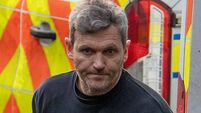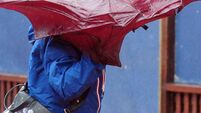Sitting on millions as they crossed the Atlantic

They had literally been sitting on millions of euro worth of cocaine while they spent weeks crossing the Atlantic, but despite the cramped conditions in the cabins of the 62ft yacht Makayabella, its three-man crew were in reasonably good health when they got an unexpected visit from the Naval Service.
The British Virgin Islands-registered yacht had been shadowed by two navy ships, LÉ Niamh and LÉ Roisín, before the order was given to pounce under cover of darkness at around 2.15am last Tuesday.
It’s believed it picked up its illicit cargo in Venezuela, made stop-off in Trinidad before heading across the Atlantic.
Two ribs (rigid inflatable boats) were dispatched from the LÉ Niamh with a 10-strong boarding party armed with pistols and batons. They clambered on to the vessel just as the navy put spotlights on it and sent it a radio message that it was being boarded.
Captain Dave Barry, the head of Naval Operations Command, said that up to then “the men had no idea” the warships were shadowing them. “They were in reasonably good condition seeing as they had been weeks at sea,” he said.
They put up no resistance and no weapons were found onboard.
Some of the navy boarding party had also been involved in a similar operation of 2008 when they seized the yacht Dances With Waves, which had €600m worth of cocaine onboard.
The Makayabella was intercepted in international waters 500kms south west of Mizen Head, Co Cork.
After securing it, the three men were transferred to the LÉ Roisín, but were not formally arrested until they were within the national jurisdiction.
The three, who remain in custody in the Bridewell Garda Station in Cork, include the 70-year-old “experienced skipper” and two others, aged 35 and 28. They are from Yorkshire.
The yacht’s sails had been damaged and according to the navy there were “issues with her engines”. This resulted in the yacht, built in 1986, being towed nearly 320kms back to Haulbowline.
There was a heavy, armed security presence at the naval base yesterday as 41 bales of cocaine, each weighing 25 kilos, were unloaded and taken to a safe location. The perceived street value of cocaine is €80,000 per kilo, meaning this seizure is worth €82m. However, if mixed with other substances, which is common, it could have netted the drugs gang considerably more.
Heads of the Irish Joint Task Force (Garda, Naval Service and Customs) held a news conference in the naval base just before showing off their capture. They said their joint co-operation and assistance from the EU-led anti-drug organisation, Maritime Analysis and Operations Centre (MAOC), had been key to the successful mission.
Assistant Garda Commissioner John O’Mahoney said the co-operation of the British National Crime Agency, as well as French customs, had made a very significant dent in the drugs gang which organised the shipment. He said the three men held in Ireland could be detained for up to a week and, in the meantime, gardaí would be preparing a file for the DPP.
Liam Irwin from Customs described the operation as “an enormous success” pointing out it was the “third major” interception of cocaine off the south-west coast in recent years.
UK police in manhunt for ‘third’ gang figure
British police have launched a major manhunt for a key figure in the drug smuggling gang behind the €80m cocaine consignment intercepted off the Irish coast.
The hunt was under way last night as three British nationals from the West Yorkshire area, arrested on board the Makayabella drugs yacht some 300 miles off the Irish coast early on Tuesday, were still being questioned by gardaí in Cork.
The National Crime Agency (NCA) in Britain was last night conducting searches across Leeds for what it described a ‘third man’, who is from West Yorkshire, as it continued questioning a second suspect who had been arrested earlier in the day as part of the major international investigation.
NCA officers, assisted by West Yorkshire Police, located the second suspect, a 47-year-old man, at an address in Leeds around lunchtime yesterday, and arrested him on suspicion of conspiring to import class A drugs.
He is being questioned at a police station in the West Yorkshire area and can be held for several days.
His arrested followed that on Tuesday of a 43-year-old man, also at an address in Leeds and also on suspicion of conspiring to import class A drugs. He has been released on bail pending further inquiries.
The NCA said it is actively pursuing the third individual.
The three are believed to have masterminded the attempt to smuggle an estimated tonne of cocaine from Venezuela, across the Atlantic on board the 19-metre Makayabella.
The ‘mother ship’ had been expected to rendezvous off the Welsh coast with a smaller vessel which would then transport the bales in several runs to the coastline.
However, the Makayabella’s movements were being constantly monitored by a range of security agencies in Ireland, Britain, France and Venezuela.
Acting on intelligence provided by the NCA and French Customs DNRED, and in co-ordination with the UK’s National Maritime Information Centre and Maritime Analysis and Operations Centre (MAOC) based in Lisbon, the Irish Naval Service intercepted the Makayabella around 300 miles off the south west coast of Ireland on Tuesday.
It was escorted to Haulbowline late on Wednesday night where it underwent a detailed forensic analysis yesterday.
zzzMakayabellaYachtDrugsSeizure_large.jpg[#embed4]
Ireland and Britain are ‘vulnerable’ entry points
Eight years ago, a United Nations drugs expert warned Columbian traffickers had identified Ireland and Britain as “vulnerable” entry points into Europe.
In an interview with the Irish Examiner in 2006, Dr Antonio Maria Costa said the cartels were penetrating the lucrative European cocaine market every way they could.
While the Iberian peninsula was the main entry point, they were exploiting the backdoor of Eastern Europe and the “vulnerable point of entry — the islands of Britain and Ireland”.
His words soon came to pass with the two biggest cocaine seizures Ireland ever had, in 2007 and 2008, each in the region of 1.5 tonnes.
The seizure in July 2007 was fortuitous in that an attempt to offload some 60 bales of cocaine off a yacht, ironically named Lucky Day, into dinghies off Dunlough Bay went awry.
It seemed the intention was to traffic the bales through Ireland — most likely Rosslare Harbour — and into Britain. Four Englishmen were convicted and another, a former British drugs officer, was jailed in England.
In November 2008, in a shipment with parallels to this week’s seizure, a yacht called Dances With Waves, was boarded by armed naval officers some 210km off Mizen Head.
Some 75 bales were uncovered, the largest seizure ever in the country. The shipment was bound for Britain, with later court hearings being told it was going to land at Carenafon Bay in Wales.
Three British nationals were jailed in 2009 for 10 years, while in Britain, the ringleader John Alan Brooks was sent down for 28 years. Brooks worked as facilitator for organised crime gangs across the world.
That seizure was the result of an intelligence operation involving gardaí, customs officers and navy, working in conjunction with the Maritime Narcotics Analysis and Operations Centre (MAOC-N), based in Lisbon and the British Serious Organised Crime Agency (Soca).
Roll on six years and we have another planned operation resulting from MAOC-N intelligence and involving the Irish agencies.
Estimates suggest the Makayabella was carrying 1.1 tonnes. Three British nationals were arrested and two more in follow-up arrests in England.
It was either bound straight for Britain or was going to be trafficked through Rosslare Port.
“This route is not unknown,” said Andrew Cunningham, scientific analyst with the European Monitoring Centre for Drugs and Drug Addiction (EMCDDA), also based in Lisbon.
“We have had several large seizures off the coast of Ireland, either destined for the UK or split up between Ireland and the UK. This one tonne seizure is a considerable seizure, a big one.”
Soca estimated in 2008 that some 350 tonnes of cocaine was consumed in the EU every year. That was at the peak of the supply and consumption of the drug, and has dropped since.
In 2009, Soca estimated that 25-30 tonnes of cocaine was imported into Britain annually, but didn’t have an estimate as to how much was coming in directly from South America.
Figures show that a total of eight tonnes of cocaine has been seized being imported into Britain between 2008 and 2010 — a small percentage of the total EU haul.
Some 71 tonnes were seized in 2012, up 10 tonnes on 2011.
“Cocaine is transported from South America to the EU across the Atlantic by air and maritime routes,” said the EMCDDA in a 2013 analysis.
“Multi-tonne shipments travel by sea from Argentina, Brazil, Chile, Colombia, Ecuador, Mexico, Peru and Venezuela to Spain and Portugal, the large ports of the Netherlands and Belgium and to major container ports in Germany, France, Italy and the United Kingdom,”
It said maritime shipments “pose the greatest problem” because large quantities can be transported at any one time.
The EMCDDA said there were three main sea routes to Europe: The northern route (passing through the Caribbean and the Azores to Portugal and Spain and northern Europe); the central route (from South America via Cape Verde or Madeira and the Canary Islands to Europe); and the African route (from South America to West Africa and from there mainly to Spain and Portugal).
There has been a sharp decline in seizures in Spain and Portugal, but a rise in hauls in Belgium, France and Italy.
“In recent years, we’ve seen a trend from sending less to the Iberian Peninsula and more into northern Europe, the likes of Belgium and the Netherlands,” said Mr Cunningham.
“Maybe this is part of a shift to northern Europe.”
He said a shipment as big as the Makayabella would tend to involve many organised crime groups, with one coordinator.
“With a one tonne mother load, it could be split down, say 100kgs to 10 organised crime groups.”












